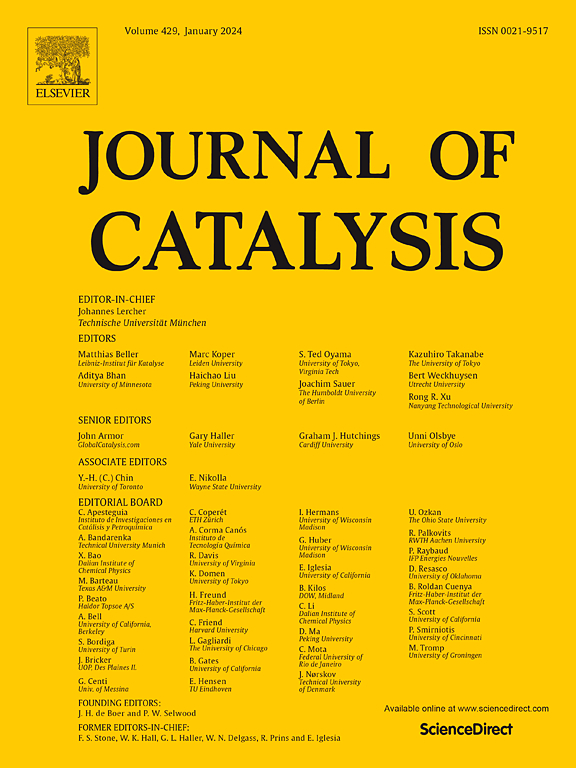碱和氯促进剂对乙烯环氧化银催化剂的影响
IF 6.5
1区 化学
Q2 CHEMISTRY, PHYSICAL
引用次数: 0
摘要
商品乙烯环氧化催化剂由α-氧化铝负载的银颗粒和含有促进剂的混合物组成。高活性催化剂通常含有Cs与其他碱促进剂和气态有机氯化物的结合。研究了不同碱种(Li, Na, K, Rb和Cs)在2.5 mol% (molalkali/(molalkali + molAg))的等摩尔负载下分别促进的一系列Ag催化剂。O2-TPD实验表明,碱性物质的存在影响了氧在银表面的吸附强度。在没有和存在工业上重要的氯乙酯促进剂的情况下进行了乙烯环氧化实验。在没有氯的情况下,碱促进催化剂的活性低于银参考催化剂,并且显示出降低的初级环氧乙烷(EO)选择性。在原料中引入氯乙酯,在不牺牲碱催化催化剂活性的情况下,将所有催化剂的初级EO选择性提高到约80 %。系统的环氧乙烷异构化实验表明,碱促进剂抑制了环氧乙烷在银表面的二次反应,而不是在载体上的二次反应。电负性较大/较弱的碱种Rb和Cs对EO降解的抑制作用大于Li和Na。然而,当向进料中引入氯乙酯时,所有催化剂的EO转化都被阻断。因此,本研究证明了氯化物和碱促进剂的组合如何影响Ag位点,特别是在增加转化率时抑制不希望的燃烧和促进期望的乙烯环氧化。本文章由计算机程序翻译,如有差异,请以英文原文为准。

Influence of alkali and chloride promoters on silver catalysts in ethylene epoxidation
Commercial ethylene epoxidation catalysts consist of Ag particles supported with α-alumina and contain a mixture of promoters. High activity catalysts typically contain Cs in combination with other alkali promoters and a gaseous organochloride. We studied a series of Ag catalysts that were individually promoted with different alkali species (Li, Na, K, Rb and Cs) at equimolar loadings of 2.5 mol% (molalkali/(molalkali + molAg)). O2-TPD experiments revealed that the absorption strength of oxygen onto the silver surface was influenced by the presence of the alkali species. Ethylene epoxidation experiments were performed both in the absence and presence of the industrially vital ethyl chloride promoter. Without the chloride, the alkali-promoted catalysts were less active than the silver reference catalyst and showed a decreased primary ethylene oxide (EO) selectivity. Introducing ethyl chloride to the feed increased the primary EO selectivity of all catalysts to ca. 80% without sacrificing the activity for the alkali-promoted catalysts. Systematic EO isomerization experiments revealed that the secondary reactions of EO are inhibited by alkali promoters on the silver surface rather than on the support. Larger/less electronegative alkali species such as Rb and Cs inhibited EO degradation to a greater extent than Li and Na. However, when ethyl chloride was introduced to the feed the EO conversion of all catalysts was blocked. This study hence demonstrates how the combination of chloride and alkali promoters affects the Ag sites, specifically suppressing both undesired combustion and promoting desired ethylene epoxidation when increasing the conversion.
求助全文
通过发布文献求助,成功后即可免费获取论文全文。
去求助
来源期刊

Journal of Catalysis
工程技术-工程:化工
CiteScore
12.30
自引率
5.50%
发文量
447
审稿时长
31 days
期刊介绍:
The Journal of Catalysis publishes scholarly articles on both heterogeneous and homogeneous catalysis, covering a wide range of chemical transformations. These include various types of catalysis, such as those mediated by photons, plasmons, and electrons. The focus of the studies is to understand the relationship between catalytic function and the underlying chemical properties of surfaces and metal complexes.
The articles in the journal offer innovative concepts and explore the synthesis and kinetics of inorganic solids and homogeneous complexes. Furthermore, they discuss spectroscopic techniques for characterizing catalysts, investigate the interaction of probes and reacting species with catalysts, and employ theoretical methods.
The research presented in the journal should have direct relevance to the field of catalytic processes, addressing either fundamental aspects or applications of catalysis.
 求助内容:
求助内容: 应助结果提醒方式:
应助结果提醒方式:


